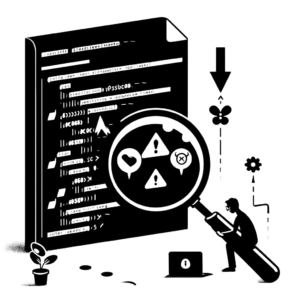Overview of Static Application Security Testing

Static Application Security Testing (SAST) is an important step in the software development process that helps find and correct security issues in a web application’s code before it goes live. SAST tools check the code for problems like SQL injections and cross-site scripting, which could be used by attackers. By using it, developers can make sure their apps are safe and protected from risks.
Using SAST is important for protecting your business from cyber threats like breaches and data leaks. By including it in your development process, you can improve your app’s security and lower the chances of cyber attacks.
The Role of SAST in Cybersecurity
Static Application Security Testing is an important tool for keeping digital information safe by identifying potential security risks in software early on in its creation. It works by examining the code of an application to find common vulnerabilities like SQL injection and cross-site scripting that could be used by attackers. This allows developers to fix security problems before the software is even launched. Including it as part of a security plan helps companies stay ahead of cybersecurity risks, prevent breaches, and make sure their software is safe to use.
How SAST Works
Static Application Security Testing is like a security guard for software, checking for any vulnerabilities or weak spots in the code before it’s released to the public. By catching and fixing these issues early on, developers can make sure their software is less likely to be hacked.
In the process, a tool is used to scan for mistakes in the code, bad coding practices, and known security issues. This helps developers fix these problems before the software is released, making it less likely to be hacked. The tool gives detailed reports on the issues found, so developers can focus on fixing the most important ones first.
By applying Static Application Security Testing while developing software, companies can make their applications more secure. This reduces the chance of data leaks and unauthorized access. Using it as a preventive safety means is crucial in today’s world where cybersecurity is important.
Types of vulnerabilities detectable by SAST
Static Application Security Testing is a really important tool for making sure that software applications are secure. Basically, it looks at the code of an application to find any potential weaknesses that could be exploited by hackers. It can detect things like SQL injection, cross-site scripting, and other security risks that could be a big problem if left unchecked. By using SAST early on in the development process, developers can find and fix these issues before they become a major security threat. It’s a key part of building safe and strong applications.

Benefits of SAST
Proactive Security and Cost Effectiveness
Checking for security issues in the code of a software application is crucial to ensure its safety. This process, known as Static Application Security Testing, allows organizations to identify and fix any vulnerabilities before hackers can exploit them. By conducting it early in the software development process, companies can protect their applications from potential security threats.
One key benefit of using a computer software checking tool, known as Static Application Security Testing, is that it can save companies money. This tool helps identify and fix any security issues early on when the software is initially developed. This helps avoid spending extra time and cost in dealing with security problems after the software is already in use. By incorporating this tool in the software development process, businesses can save significant money over time. This is because finding and repairing security weaknesses tends to cost a lot more when they’re discovered later in the software development process.
Compliance with Regulations
Static Application Security Testing helps protect your personal information online by checking the code of a program for vulnerabilities that could be exploited by hackers. By conducting this type of testing, companies ensure they are following regulations like GDPR, HIPAA, and PCI DSS to safeguard important data.
Static Application Security Testing is important for keeping applications secure and protecting them from cyber threats that could result in financial and reputational harm. By incorporating SAST tools into the software development process, companies can find and resolve security issues before they go live, lowering the chances of cyber attacks and guaranteeing that their applications meet industry regulations.
Limitations of SAST
False Positives and Negatives
When using Static Application Security Testing, it’s important to know about false positives and false negatives. False positives happen when a tool mistakenly says code is insecure when it’s actually safe. This can waste time and resources looking into issues that aren’t there. On the flip side, false negatives occur when a tool misses a real security problem, which leaves the application at risk of being hacked.
Addressing false positives and negatives in SAST tools is essential for effective vulnerability management. By fine-tuning the tool’s settings and ensuring that developers are properly trained to interpret and prioritize the results, organizations can maximize the benefits of SAST and enhance the overall security posture of their applications.
Inability to Catch Runtime Vulnerabilities
Static Application Security Testing is an important tool in cybersecurity that helps identify flaws in a program’s code before it is actually used. However, a limitation of it is that it may not catch issues that only arise when the program is running, known as runtime vulnerabilities.
While it can analyze code to find security flaws, it cannot mimic the actual runtime environment of the application. This means that certain vulnerabilities, such as those caused by user input or data dependencies, may go undetected by scans. As a result, organizations must complement SAST with other security testing methods, such as Dynamic Application Security Testing (DAST) and penetration testing, to ensure comprehensive coverage of their applications’ security posture.
Understanding the limitations of SAST and the importance of addressing runtime vulnerabilities is essential for organizations looking to strengthen their overall security defenses and protect their applications from potential cyber threats.
Significance of SAST in Modern Cybersecurity
Static Application Security Testing helps keep your digital information safe by looking for potential security issues in the code of an application before it goes live. By finding and fixing problems like hackers trying to steal information or mess with your site, it can save time and money while also protecting your data from cyber attacks. Using it is an important part of making sure that your software is safe and secure in today’s online world.
As we look into the importance of SAST and why it’s important, we see that it plays a key role in finding vulnerabilities early on in the software development process. It checks the source code for security issues without actually running the application, giving developers a heads-up on potential problems and helping them fix issues quickly. In the future, it is expected to become more automated and integrated with DevOps practices. As cyber threats become more advanced and software gets more complex, SAST tools will need to keep up with these changes. Using it as a regular part of the development process won’t just make applications more secure, but it will also help build a proactive cybersecurity culture in organizations.
